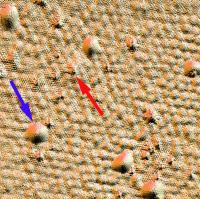Home > Press > Speed bumps less important than potholes for graphene
 |
| Comparison of an STM topographic image of a section of graphene sheet (top left) with spectroscopy images of electron interference at three different energies shows strong interference patterns generated by atomic scale defects in the graphene crystal (red arrows) but only modest disturbances caused by larger scale bumps in the sheet (blue arrows.) Analysis of the ripples shows that the electron energy in graphene is inversely proportional to its wavelength, just like light waves. The area imaged is approximately 40 nanometers square.
Credit: NIST/Georgia Tech |
Abstract:
For electrical charges racing through an atom-thick sheet of graphene, occasional hills and valleys are no big deal, but the potholes—single-atom defects in the crystal—they're killers. That's one of the conclusions reached by researchers from the National Institute of Standards and Technology (NIST) and the Georgia Institute of Technology who created detailed maps of electron interference patterns in graphene to understand how defects in the two-dimensional carbon crystal affect charge flow through the material. The results, appearing in the July 13 issue of Science*, have implications for the design of graphene-based nanoelectronics.
Speed bumps less important than potholes for graphene
Gaithersburg, MD | Posted on July 12th, 2007A single layer of carbon atoms tightly arranged in a honeycomb pattern, graphene was long thought to be an interesting theoretical concept that was impossible in practice—it would be too unstable, and crumple into some other configuration. The discovery, in 2004, that graphene actually could exist touched off a rush of experimentation to explore its properties. Graphene has been described as a carbon nanotube unrolled, and shares some of the unique properties of nanotubes. In particular, it's a so-called ballistic conductor, meaning that electrons flow through it at high speed, like photons through a vacuum, with virtually no collisions with the atoms in the crystal. This makes it a potentially outstanding conductor for wires and other elements in nanoscale electronics.
Defects or irregularities in the graphene crystal, however, can cause the electrons to bounce back or scatter, the equivalent of electrical resistance, so one key issue is just what sort of defects cause scattering, and how much" To answer this, the NIST-Georgia Tech team grew layers of graphene on wafers of silicon carbide crystals and mapped the sheets with a custom-built scanning tunneling microscope (STM) in the NIST Center for Nanoscale Science and Technology that can measure both physical surface features and the interference patterns caused by electrons scattering in the crystal. (Graphene on silicon carbide is a leading candidate for graphene-based nanoelectronics.)
The results are counter-intuitive. Irregularities in the underlying silicon carbide cause bumps and dips in the graphene sheet that lies over it rather like a blanket on a lumpy bed, but these relatively large bumps have only a minor effect on the electron's passage. In contrast, missing carbon atoms in the crystal lattice cause strong scattering, the interference patterns rippling around them like waves hitting the piles of a pier. From a detailed analysis of these interference patterns, the team verified that electrons in the graphene sheet behave like photons, even at the nanometer scale.
This work is supported in part by the Office of Naval Research, National Science Foundation, and Intel Research.
* G.M. Rutter, J.N. Crain, N.P. Guisinger, T. Li, P.N. First and J.A. Stroscio. Scattering and interference in epitaxial graphene. Science 13 July 2007.
####
For more information, please click here
Contacts:
Michael Baum
301-975-2763
Copyright © National Institute of Standards and Technology (NIST)
If you have a comment, please Contact us.Issuers of news releases, not 7th Wave, Inc. or Nanotechnology Now, are solely responsible for the accuracy of the content.
| Related News Press |
Nanoelectronics
![]() Lab to industry: InSe wafer-scale breakthrough for future electronics August 8th, 2025
Lab to industry: InSe wafer-scale breakthrough for future electronics August 8th, 2025
![]() Interdisciplinary: Rice team tackles the future of semiconductors Multiferroics could be the key to ultralow-energy computing October 6th, 2023
Interdisciplinary: Rice team tackles the future of semiconductors Multiferroics could be the key to ultralow-energy computing October 6th, 2023
![]() Key element for a scalable quantum computer: Physicists from Forschungszentrum Jülich and RWTH Aachen University demonstrate electron transport on a quantum chip September 23rd, 2022
Key element for a scalable quantum computer: Physicists from Forschungszentrum Jülich and RWTH Aachen University demonstrate electron transport on a quantum chip September 23rd, 2022
![]() Reduced power consumption in semiconductor devices September 23rd, 2022
Reduced power consumption in semiconductor devices September 23rd, 2022
Discoveries
![]() Researchers develop molecular qubits that communicate at telecom frequencies October 3rd, 2025
Researchers develop molecular qubits that communicate at telecom frequencies October 3rd, 2025
![]() Next-generation quantum communication October 3rd, 2025
Next-generation quantum communication October 3rd, 2025
![]() "Nanoreactor" cage uses visible light for catalytic and ultra-selective cross-cycloadditions October 3rd, 2025
"Nanoreactor" cage uses visible light for catalytic and ultra-selective cross-cycloadditions October 3rd, 2025
Announcements
![]() Rice membrane extracts lithium from brines with greater speed, less waste October 3rd, 2025
Rice membrane extracts lithium from brines with greater speed, less waste October 3rd, 2025
![]() Researchers develop molecular qubits that communicate at telecom frequencies October 3rd, 2025
Researchers develop molecular qubits that communicate at telecom frequencies October 3rd, 2025
![]() Next-generation quantum communication October 3rd, 2025
Next-generation quantum communication October 3rd, 2025
![]() "Nanoreactor" cage uses visible light for catalytic and ultra-selective cross-cycloadditions October 3rd, 2025
"Nanoreactor" cage uses visible light for catalytic and ultra-selective cross-cycloadditions October 3rd, 2025
|
|
||
|
|
||
| The latest news from around the world, FREE | ||
|
|
||
|
|
||
| Premium Products | ||
|
|
||
|
Only the news you want to read!
Learn More |
||
|
|
||
|
Full-service, expert consulting
Learn More |
||
|
|
||








